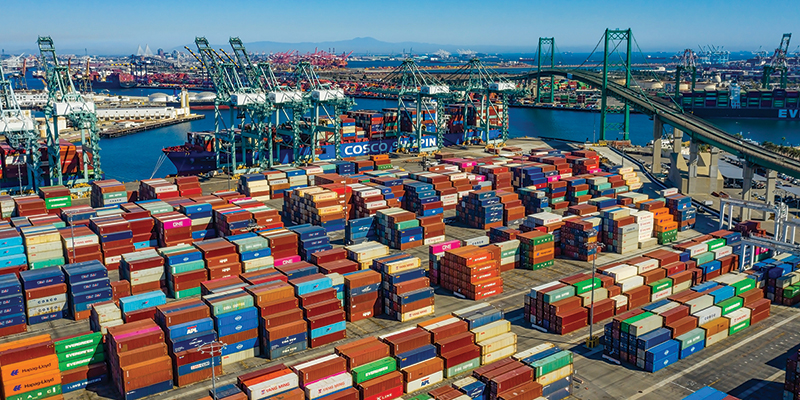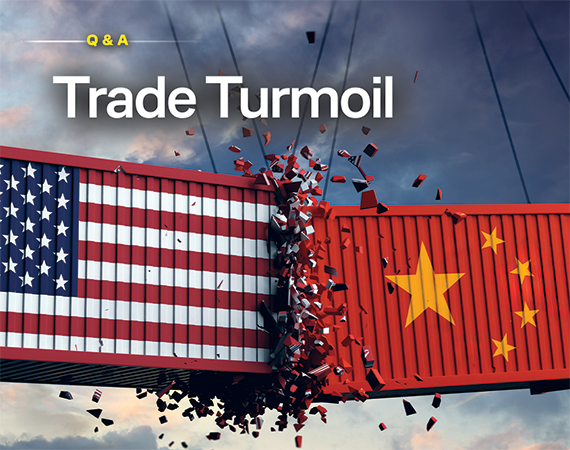
Enterprise Minnesota president and CEO Bob Kill recently interviewed supply chain authority Willy Shih, the Robert and Jane Cizik Professor of Management Practice in Business Administration at Harvard Business School, about the impact of impending tariffs and the unpredictable trade climate on manufacturers. Kill first spoke with Shih in late March, prior to the Trump administration’s major tariff announcements on April 2, or “Liberation Day.” Dramatic changes in those announced policies warranted a second conversation with Shih in late May. As this magazine was finalized for publication, the triple-digit tariffs imposed on China were on a 90-day pause. The Trump administration was also in the midst of bilateral discussions with other trading partners to avert the punitive tariffs announced on April 2 but suspended until July 9.
Three major themes emerged from these discussions. Shih pointed out the historic shift from an increasingly free global trade climate in the late 20th and early 21st centuries, to growing barriers to international trade beginning with the first Trump administration. He also discussed the consequences, both intentional and unintentional, of the recent trade policy changes. Finally, Shih detailed actions manufacturers can take to survive the new trade environment.
Bob Kill: The challenge of this discussion is that the tariffs are constantly changing. Will you look at this interview in a month and change 50% of what you’ve said?
Willy Shih: We do have to preface everything with, “By the time this comes out…”
One thing that will stand the test of time is that we’ll look back on what I would call the golden age of globalization, which was the late 1990s until probably around 2009. It was a time of constantly decreasing trade barriers and tariffs, and a time of spectacular growth.
Beginning in the early 1980s, when I entered the workforce, the tradable sector was constantly growing. I was bringing imports from Europe into the U.S. on a weekly charter flight. When I traveled to Europe, I had to bring Deutsche marks, British pounds, Swiss francs and French francs. Now of course it’s the euro in the Eurozone.
Tariffs and trade barriers just kept coming down. You had the introduction of the shipping container, growth in global air cargo, and enormous improvements in communications. And then we saw giant container ships that made long-distance oceanic shipping really inexpensive. All this increased the size of the tradable sector — the goods that can be made in one place and consumed far away.
What’s going on now is we’re decreasing tradability. We’re making it harder and more expensive to move goods across borders. It’s turning back the clock. We’ve been through this period where there’s been relatively free, relatively open trade. People have built their supply chains assuming there aren’t those barriers. Now we’re going to go put those barriers back in. That’s a problem.
Kill: What are the most significant consequences of the tariff turmoil right now?
Shih: What’s killing people right now are the day-to-day changes and the unpredictability.
Every day the news says something different. Everybody wants to wait until the dust settles until they make any kind of long-term commitments or bigger investments. That’s very hard on a lot of the small businesses that may not have the capital to see themselves through this period of turbulence.
Also, since the election people have known that tariffs were going to be a problem so there’s been a lot of front-running, and by that I mean bringing cargo in early in advance of when tariffs will hit. Normally there’s a peak season on the trans-Pacific trade lane, and the peak season starts to wind down in late November because typically if you can’t get it in before the holidays you can’t get it into the store. Peak season didn’t end this past holiday season. It went right up until Chinese New Year, and in fact, if you look at inventory levels, at Walmart, at Target, places like that, they were up sharply.
People are trying to get as much of this stuff into the country before tariffs hit. But that creates its own set of problems, because now you have too much inventory. We saw what happened during the pandemic: too much inventory, too little inventory. But worse than that, you have a lot of cash tied up.
Once the tariffs are in place, there’s the complexity of complying. I was in an aerospace components factory in Ontario, Canada. The steel or titanium for those components would come from the U.S. or another country. They would make the component, then send it to Oklahoma for heat treating. And then they would send it back over the border for another step, and then across the lake to Ohio for more processing. Sometimes these parts cross borders six or seven times.
So how do you assess the tariff on that? Is it applied every time it crosses the border, or do I get credit for having paid the tariff when it went previously, as a lower value component? What happens if it’s steel? There’s a separate steel tariff, and then there’s a generalized tariff on everything coming from this country. Do I stack the tariffs? There’s just a lot of detail in terms of how this will all be executed. And still, no one knows how these will be executed.

Kill: Though the tariffs are still up in the air, do you see unintended consequences stemming from other trade-related policy changes?
Shih: Yes. It’s a very complex system, and for every one of these changes, there’s potential for collateral damage.
When you stop the de minimis exemption [a provision that allows qualifying, low-value shipments valued at less than $800 to enter the U.S. duty-free, which streamlines customs procedures and reduces administrative burdens for small-value transactions], all of a sudden you have to file a lot of paperwork and do inspections, and you get a 1 million package pile up at JFK Airport in one day.
Another example is a proposal to charge Chinese-made ships for every port call. These are huge ships, so a $1 million fee would end up being maybe a couple hundred bucks per container. The way container lines operate, if I bring a ship from Asia across the Pacific, I’ll come into Long Beach and unload. Then I might go up to Oakland and pick up agricultural products. Or I might go up to Seattle/Tacoma and pick up more containers.
If I get charged for every port call, maybe I’ll come into Los Angeles/Long Beach and just head back to Asia to avoid that access fee. Then the agricultural exporters wouldn’t have enough capacity out of Oakland anymore. They’ll have to bring everything down to Los Angeles/Long Beach. These are the kinds of things that increase barriers and inefficiencies and increase costs. It would make it more expensive to export a lot of those products. That was certainly not the intent of that proposal.
Kill: It seems likely that most of the tariffs will eventually settle at rates higher than we are used to. In a broad sense, how do you expect permanent, higher tariffs to affect supply chains and pricing?
Shih: Look at fresh produce as an example. People want to enjoy seasonal fruits and vegetables, even when they are out of season. Historically, people generally ate just the produce that was in-season. You ate strawberries when they could be grown in California or Florida or New Jersey. You ate grapes from August until October. Now growers can bring those products in from the Southern Hemisphere or from all over the world and extend the season.
But if you apply a 25% tariff, that’s more than the profit margin they make from growing and distributing. Who’s going to pay for that? The grocers and distributors set the price, and then the foreign growers will have to decide if they can afford to import once they apply the tariffs. They might pay the tariffs this year, and then next year they might decide not to plant.
Either the price has to go up so that the grocers are willing to pay more to have them out of season, or we’ll go back to eating seasonal produce only when it is in season. Tariffs will have the same effect on manufactured goods. Once you start applying tariffs broadly to the countries that are principal sources of supply, either prices will go up, or the supplies will be very limited.
Kill: Will some manufacturers lose customers because of this?
Shih: You could see a lot of collateral damage if there are no exemptions for certain imports, which there were during the first Trump administration, if certain materials and components couldn’t be sourced domestically. It remains to be seen if that will happen again.
I have this part on my desk — it’s part of a brake assembly that goes on a Boeing 787. This is a special high strength, high temperature steel that is only made in Austria. It’s the only material that is certified for this kind of aircraft usage. An Ohio manufacturer imports that steel, turns it into the part, and sends it back to France, where it becomes part of the landing gear that they ship back to the Boeing factory in South Carolina to put in a 787.
The problem is, the French guy sees your cost just went up because of the tariffs, so why send it to Ohio? Why not get somebody in France to make it? During Trump’s first administration this manufacturer got an exemption. But they are saying there will not be any exemptions this time.
Kill: Do we have enough domestic capacity to make what we need here? Is there a source for high performance ball bearings, for example, or are there some components that just have to come from outside the country?
Shih: We still make a lot of things, but we don’t make them in the quantities we need for mass production. We do make printed circuit boards in the U.S., for example, but by and large they are for the aerospace and defense markets. But when you need domestic production for broader markets, they’ll cost a hundred times as much as imports. That cost doesn’t matter to defense and aerospace; they have to be made domestically [for security reasons].
The other question is, could you scale up production? If you want to bring all this stuff on shore, you need a lot of investment. The latest circuit boards are very complex, and you’d have to have a lot of expensive equipment to manufacture them. There’s also the issue of raw materials. We just had the last electrolytic copper foil producer in the U.S. say they were closing shop in February.
They were in South Carolina. All the aerospace users, who don’t need much volume, just bought something like a 10-year supply.
Another example is aluminum. So much of the cost of aluminum is driven by the cost of electricity. Quebec has low-cost hydroelectric power, so their cost of electricity is much lower than it is in the U.S. Domestic aluminum makers would have a hard time being competitive. If you put a tariff on imported aluminum, for any manufacturer that has aluminum as a significant part of their bill of materials, their costs will suddenly go up.
Kill: What should manufacturers do to prepare for the general shift toward increased trade barriers?
Shih: The thing that I’ve learned the most since the pandemic is that you have to pay attention to what’s going on in the logistics stuff. It’s easy to forget that there’s inventory in transit, which may suddenly get subject to duties. Some importers have somebody who’s focused on logistics networks, who’s watching the trade lanes, who knows what traffic looks like in the Red Sea, who’s on top of port delays in Ningbo and Shanghai. These days, that can inform you a lot in terms of what problems to anticipate.
Manufacturers also need to think about how to get more flexibility in sourcing. It used to be that importers used a strategy of China plus one. They added some step of production in another country, Vietnam, for example, so that country is the source of the product. But the current mindset of the administration seems to be driven by who has a bigger trade surplus. The three countries with the biggest trade surpluses are China, Mexico and Canada, and that’s why they were the first three to get hit. You can see who else will get hit based on trade imbalances. If you’re bringing stuff in from Vietnam, Germany, Japan, or Korea, your day will come sooner rather than later. Pay attention to things like that.
Kill: How should companies manage their supply networks right now, during this period of uncertainty?
Shih: They need to keep an ear to the ground and listen to what’s going on. They should also do some scenario planning with their customers and their suppliers to figure out how they are going to deal with these things.
If you have a long supply chain with a lot of links and you put a shock in the front, it takes a while to propagate through. A manufacturer might have a supplier in the U.S. who is dependent on imports. There were all these canceled sailings in April. If that supplier stopped importing in April, but didn’t have an alternative, the question is, how much inventory does that supplier have before they run dry? Manufacturers need to understand how much inventory is in the pipeline, when they are going to run out of parts, and when they might have to stop production.
Even though they’ve paused the tariffs, that shock still comes through because after April 2, basically everything coming out of China got shut down. If you rely on components or parts that come out of China, you’re going to run out. The administration is imposing new tariffs or rules on a day-to-day basis, but supply chains respond on a much longer time constant.
Hopefully manufacturers have ordered ahead on critical inputs coming from China. If they order ahead, they will have to find additional storage space. They’ll have that cost, and the cost associated with carrying inventory. And there’s always the risk of obsolescence when you’re carrying that kind of inventory.
Kill: Is this a wakeup call for how they deal with suppliers over the long term?
Shih: Manufacturers need to be flexible when they work with domestic suppliers. They need to focus on long-term relations and not just be so transactional.
I’ll give you an example. I was in the Toyota factory in Georgetown, Ky. last summer. They make sedans competitively in the U.S., but the Detroit automakers can’t make sedans competitively in the U.S.
Most of that factory’s suppliers are in Kentucky, Tennessee, Ohio, Alabama, and Indiana. I was looking at their incoming steel. And I said, “You use American-made steel. That’s more expensive than the imported stuff.” They responded that they have a strategic long-term relationship with their suppliers. They use a special steel that an American steel mill makes. They will have ups and downs, but they are committed to a long-term relationship with that supplier, and I’m sure they get it at a better cost. There is wisdom and insight in that in terms of companies’ relationships with their suppliers. You can build long-term strategies to weather this kind of storm.
Kill: If companies are bringing more production back to the U.S. from low-cost countries, what can they do to boost productivity?
Shih: When you moved production offshore in the past, you had to pay for the factory, pay for moving the supply chain, pay for hiring and training the workers. You got a lower product cost, so that move paid for itself in a short time. That works when you’re going from a high-cost country to a low-cost country.
When you’re going from a low-cost country to a high-cost country, it doesn’t work. You don’t get cost savings that pay for the move. What we’re trying to do is we’re trying to get American manufacturing competitive again. Growing American manufacturing when it’s not competitive means everything is going to cost more. To make it competitive again, you’ve got to be more productive. And that means using automation when you can.
I see a lot of resistance to automation because we’re afraid that it’s going to take away the jobs. The problem is, if American manufacturing doesn’t have high labor productivity, there are a lot of things you cannot afford to make here. If you’re going to make it in the U.S., you have to be competitive on cost. You have to have the best productivity in the world.
Manufacturers can start with automating some of the simpler tasks, like palletizing and heavy lifting. Those aren’t great jobs, and they should automate as much of that as they can anyways. It’s all about getting productive and getting globally competitive. If you can do that, there are great jobs to be had. But this belief that automation takes away jobs — we’ve got to get over that.
Kill: The 90-day pause on the China tariffs doesn’t expire until August, but other countries have a July 9 deadline before reverting to the April 2 rates. What do you think will happen then — maybe an extension of the pause?
Shih: I think a lot of people are saying there’s going to be a 10% universal baseline, which is probably going to apply to everybody. That’s significantly higher than where the U.S. was. And then I think what you’re going to see is sectoral tariffs on particular sectors. I think that’s going to depend on who the trading partner is and what kind of deal they can negotiate.
I think the bigger impact will be the macro effects, because all this rapid change in policy is causing a lot of uncertainty, and that’s freezing investment decisions. If they don’t resolve it, and they continue to push it to later dates, then those macro problems persist. Then all you end up doing is freezing everybody’s ability to invest because with that level of uncertainty, nobody’s going to invest in a new factory in the U.S. when the rules change every few weeks or days. You need to have some stability before you have the confidence to do that.
Return to the Summer 2025 issue of Enterprise Minnesota® magazine.


